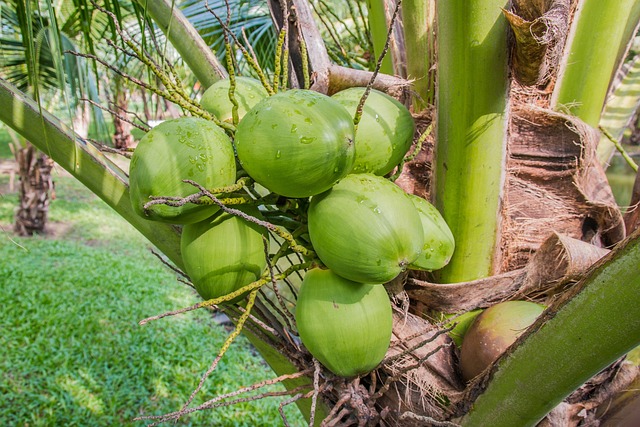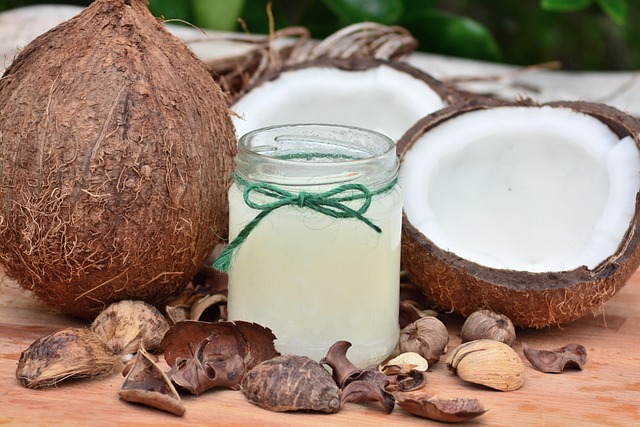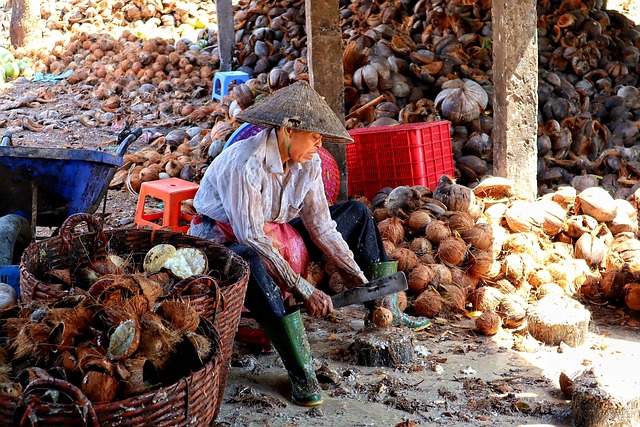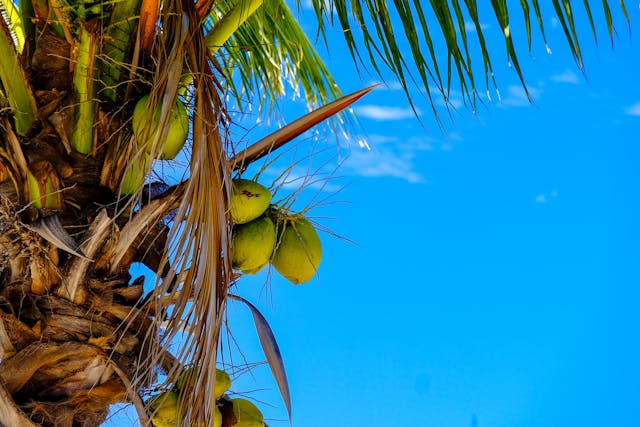
Coconut in Thailand is more than just a tropical fruit — it’s a cultural icon. Known as Ma-Praow in Thai, the coconut plays a key role in Thai cuisine, traditional medicine, religious rituals, and local craftsmanship.
Why Is Coconut So Important in Thailand?
A Millennia-Old Presence in Everyday Life
Coconut trees are a defining feature of the southern Thai landscape. They provide food, shelter, tools, and natural remedies. The fruit is revered for its purity and versatility.
Symbolism, Rituals & Sacred Ceremonies
Coconuts are commonly offered at temples as symbols of purity and prosperity. They also feature in weddings, Buddhist rituals like Visakha Bucha, and house blessings.
Coconut Festivals and Local Traditions
In provinces like Samut Sakhon and Surat Thani, coconut harvest festivals include shows, coconut tree climbing contests, and tasting sessions.
The Surat Thani Coconut Festival, held every April, features climbing competitions, parades, and vibrant markets showcasing coconut-based products — a great opportunity to learn about the palm’s cultural importance in this coastal province.
Nutrition & Traditional Thai Medicine
Coconut Water: A Natural Hydration Source
Naturally isotonic, coconut water is widely consumed in Thailand. It’s used to beat the heat, rehydrate during illness, or cleanse the body in rituals.
Coconut Oil: Food and Remedy

Used in both cooking and cosmetics, coconut oil is believed to support heart health, nourish skin and hair, and relieve digestive issues or pain through massage in traditional medicine.
Uses in Traditional Thai Remedies
Grated flesh, coconut milk, and even shells are used in herbal remedies to treat fever, skin infections, and digestive problems.
Green vs. Mature Coconut
| Criteria | Green Coconut | Mature Coconut |
|---|---|---|
| Outer Appearance | Green, smooth, young | Brown, fibrous, dry |
| Flesh | Soft, jelly-like, tender | Thick, firm, grateable |
| Coconut Water | Plentiful, sweet, hydrating | Minimal or absent |
| Uses | Refreshing drink | Milk, oil, grated, cooking |
| Market Price | Very affordable (10–20 THB) | Varies by processing |
Varieties of Coconut in Thailand: From Nam Hom to Traditional Types
Thailand cultivates several coconut varieties, each with unique traits. The most famous is the Nam Hom variety, prized for its fragrant, sweet water and often exported as a premium product. Another is the Maphrao Kathi, used primarily for coconut milk and oil production due to its thick, rich flesh.
Nam Hom Varieties: Kon Chip vs. Kon Klom
The famous Nam Hom coconut comes in two subtypes: Kon Chip and Kon Klom. Kon Chip has an elongated, slightly pointed base and is more commonly found in fresh markets. Kon Klom, on the other hand, is rounder and often chosen for export due to its thicker husk, which enhances shelf life. Both are highly aromatic and prized for their sweet water.
Glossary of Thai Coconut Terms
-
- Ma-Praow (มะพร้าว) – The general Thai word for “coconut.”
- Nam Hom (น้ำหอม) – Literally “fragrant water,” a coconut variety known for its sweet aroma.
- Maphrao Kathi (มะพร้าวกะทิ) – A mature coconut type rich in flesh, ideal for milk and oil production.
- Kon Chip / Kon Klom – Subtypes of Nam Hom coconuts: elongated or rounded, with different export preferences.
In Thai Cuisine: Sweet & Savory Delights
Iconic Soups & Curries
Tom Kha Gai (chicken coconut soup) and Panang curry both use coconut milk to soften spices and create depth.
Traditional Desserts & Street Snacks
Kanom krok, small rice and coconut cakes, and Khao Niew Mamuang (sticky rice with Thai mango and coconut milk) are Thai market staples. For more irresistible bites found in local markets, check out our guide to must-try Thai street snacks.
Fresh Coconut-Based Drinks
Smoothies, young coconut juice, and coconut milk infusions are popular in street stalls and trendy cafés alike.
Easy Thai Recipes with Coconut to Try at Home
- Tom Kha Gai: Simmer galangal, lemongrass, and kaffir lime leaves in coconut milk, add chicken and mushrooms, finish with lime juice and coriander.
- Khao Niew Mamuang: Cook sticky rice, soak in sweet coconut milk, serve with ripe mango and salty coconut cream.
Crafts, Beauty & Coconut Cosmetics
Coconut Shell Handicrafts
Coconut shells are repurposed into bowls, lamps, musical instruments, and jewelry sold at markets and local craft centers.
Natural Beauty Products
Coconut-based creams, soaps, shampoos, and balms are widely available and appreciated for their natural gentleness.
Tourism & Coconut Experiences
Visiting Coconut Plantations
In Samui, Chumphon, or Phetchaburi, plantations welcome visitors to learn about coconut cultivation and production.
Handicraft Workshops & DIY Souvenirs
Some workshops let you create your own coconut bowl or jewelry — a fun and sustainable family-friendly activity.
Immersive Coconut-Themed Experiences
Guided tours often include tastings, coconut cooking demonstrations, or walks through coconut groves.
Agriculture, Sustainability & Ethical Production

Examples of Sustainable Coconut Farming in Thailand
In Chumphon, certified organic cooperatives like “Southern Green Growers” use drip irrigation and crop rotation. In Nakhon Si Thammarat, EU-funded agroforestry programs combine coconut with legumes and herbs to improve biodiversity and reduce pesticide use.
Lifecycle of a Coconut Tree in Thailand
From planting to first harvest, a coconut tree takes about 6–7 years to mature. It then produces fruit continuously for up to 60–70 years.
This infographic illustrates the major stages: seedling, sapling, maturity, peak productivity, and gradual decline — a cycle deeply tied to Thai agriculture and livelihoods.
Social Impact and Working Conditions in Thailand’s Coconut Industry
Manual labor is still prevalent in the coconut industry. Some farms use trained monkeys for harvesting, a controversial practice. Small producers often earn little, but initiatives like cooperatives and Fair Trade certifications aim to ensure better wages and conditions.
Environmental Impact of Coconut Farming
Though drought-resistant, coconut monocultures can harm soil and biodiversity. Agroforestry and crop diversification are key strategies adopted by many farmers to maintain environmental balance.
Sources and References
Figures are drawn from the OAE, Thai Ministry of Agriculture, FAO, ITC, and FairTrade International.
Exports & Global Market
A Market Worth Hundreds of Millions USD
Thailand ranks third globally in coconut exports. In 2024, it exported over 29 billion baht in products like virgin oil, pasteurized coconut water, and dried flakes for food industries worldwide.
Processed Products: Oil, Sugar, Milk & Fiber
The majority of exports include virgin coconut oil and packaged coconut milk, along with sugar and coir for industrial use.
Competition & Thailand’s Strategy in Asia
Facing competition from the Philippines and Indonesia, Thailand focuses on quality, organic certifications, and traceability to stand out.
Coconut and Major Thai Festivals
During Songkran, coconut water is used in blessing rituals. For Loy Krathong, coconut shells serve as eco-friendly floating offerings — reflecting the fruit’s sacred and natural role in Thai festivals.
FAQ: Coconut in Thailand
Can I drink coconut water straight from a green coconut?
Yes, absolutely. In Thailand, fresh green coconuts are often chilled and sold with a straw for immediate hydration. It’s safe, delicious, and refreshing.
What’s the difference between coconut milk and coconut water?
Coconut water is the clear liquid found inside green coconuts. Coconut milk is made by blending the grated white flesh of mature coconuts with water, resulting in a creamy texture used in Thai cuisine.
Where can I experience coconut farming in Thailand?
Regions like Samui, Chumphon, and Nakhon Si Thammarat offer guided tours, tastings, and even craft workshops in coconut farms.
Are Thai coconuts organic?
Many are. Organic farming practices are growing, especially in cooperatives that export to Europe and Japan. Look for certification labels when buying packaged products.
Conclusion: A Fruit That Nourishes Body and Soul

More than just a fruit, coconut in Thailand reflects a way of life. From temple rituals to global exports, from ancestral farming to sustainable innovation, it bridges tradition and future. It’s a story of taste, resilience, and connection — rooted in Thai soil and spirit.
Explore more tropical treasures like the Thai durian or the refreshing mangosteen.
🔄 Last updated on May 4, 2025
